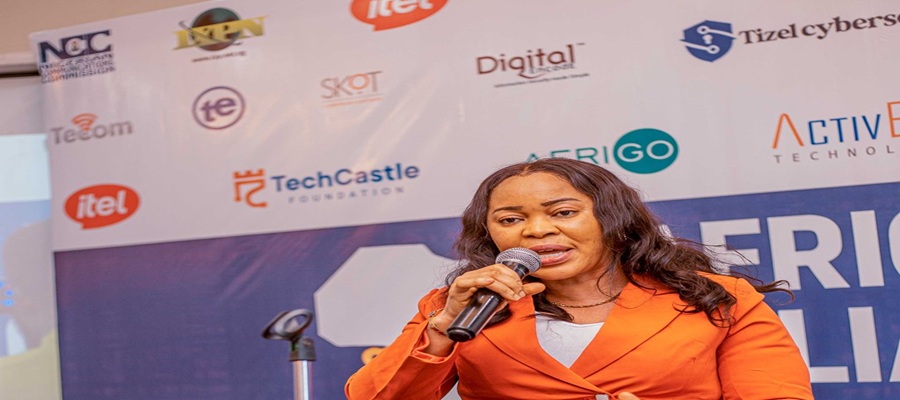Telecom
Sophos Releases 2017 Malware Trends, Prediction

By peter oluka
From online gaming, to mobile apps and wearable tech, technology is used at almost every touch point in people’s day-to-day lives. However, the downside of living in this hyper-connected society means that people are also extremely vulnerable to cyber-attacks.
This year’s Malware Report from Sophos reveals just how malware is being weaved into this everyday technology, and how, year on year, we are seeing cybercriminals become more intelligent in their attacks, making it increasingly important for consumers to be wary of the dangers out there.
Whilst many consumers may live in denial that an attack like this will ever affect them, Sophos’ research revealed the opposite. Harish Chib, VP MEA at Sophos, reviews the most prominent risks from 2017, and what we can expect in 2018.
- The extent of ransomware attacks from 2017
- How online gaming was used to catch consumers off-guard
- The level of malicious Android apps detected this year
- 2018 thoughts and predictions
Sophos 2017 Malware trends and predictions
- Ransomware is on every platform – don’t assume your mobile and tablets are safe
This year, WannaCry shook the world as the cyber hi-jack accounted for more than 45% of all ransomware tracked, closely followed by Cerber at 44.2%, according to Sophos’ most recent Malware Report.
In September alone, 30.4 percent of malicious Android malware processed by SophosLabs was ransomware. Sophos expects this to jump to approximately 45 percent in October. The majority of these attacks have targeted Windows users, but the number of attacks on other platforms is increasing, including those targeting Android, Macs and Linux.
Ransomware attacks have shifted in focus in the past two years, towards industries which are most likely to pay up, such as healthcare, government, critical infrastructure, and small businesses. Due to it being one of the most lucrative industries from ransomware payments or selling medical records, Healthcare has been a big target in 2017 and will without a doubt continue that way into 2018.
- Malware is hiding in Android Apps
When reviewing Google Play, Sophos found that the number of different threats had doubled since last year. One type of malware, dubbed ‘GhostClicker’, sat in Google Play for almost a year, disguising itself as part of the service library. It then request device administration permission, and actively simulated click-on advertisements as it delivered to earn revenue.
One of the more sobering finds was Lipizzan, spyware that infected up to 100 devices. Although this doesn’t sound like a large number, it seems this was a targeted, precision malware, which was designed to monitor phone activity and extracting data from popular apps including email, SMS, location, and voice calls, and media.
Malware such as this is showing no sign of reducing in the future, as cyber criminals know it works. Therefore, in order to combat being a victim of Android malware, Sophos would suggest consumers:
- Stick to Google Play – Although it isn’t perfect, it puts plenty of effort into preventing malware arriving in the first place
- Avoid apps with a low reputation – Be especially wary of this when using a work phone
- Patch early, patch often – Check the vendors attitude to updates
- Online gaming is being used to spread Ransomware and Malware
In terms of online gaming, fake copies of the popular game, ‘King of Glory’ were used to spread ransomware this year. The warning screen used mimicked the one used during the WannaCry outbreak, directing individual to pay the ransom through the China-based Wechat, Alipay and QQ payment methods.
The number of malicious apps has risen steadily in the last four years, peaking at nearly 3.5 million in 2017, therefore we are likely to see this rise further in 2018, including more deceptive online gaming traps.
- Data breaches– they are not going away
The downside of living in this hyper-connected society means that people are extremely vulnerable to cyber-attacks, as shown in the past few weeks with the Uber Hack, which affected 2.7 million riders and drivers. Sadly, we don’t see these data breaches diminishing in 2018, and with GDPR coming into effect in May it will only continue to be a hot topic and something we are continuing to see.
- 2018 and beyond
It’s impossible to predict what will happen in 2018, however it’s a fair bet that Android and Windows will continue to be heavily targeted with ransomware and other Malware. Email will also remain the primary attack vector threatening corporate cyber security, especially in the case of targeted attacks.
Four trends that stood out in 2017, and will likely dominate 2018 are:
- A ransomware surge fueled by RaaS and amplified by the resurgence of worms;
- An explosion of Android malware on Google Play and elsewhere;
- Continued efforts to infect Mac computers; and
- Ongoing Windows threats, fueled by do-it-yourself exploit kits that make it easy to target Microsoft Office vulnerabilities.
Telecom
Nigeria Lacks AI-Ready Data Centres, Trails in Capacity – Nnamani

Engr. Ikechukwu Nnamani, Chief Executive Officer of Digital Realty Nigeria, says the country currently has no data centres designed for core Artificial Intelligence (AI) applications despite the presence of over 300 AI firms operating locally.

Engr.Nnamani
Nnamani made the disclosure at the Nigeria Information Technology Reporters Association (NITRA) Breakfast with CEOs in Lagos, stressing that AI is driving the next phase of digital evolution but Nigeria’s facilities remain unprepared for its intensive demands.
“There’s no data centre in Nigeria that is AI ready. None,” he said, noting that while cloud services exist, core AI infrastructure is absent, forcing local companies to rely on foreign resources.
He projected that AI-enabled data centres could emerge in two to three years through global players such as Digital Realty, citing its South African subsidiary, Teraco, which operates Africa’s largest facility.
He explained that one Teraco site exceeds the combined capacity of all Nigerian data centres and has already implemented liquid-cooled AI-ready infrastructure.
On national capacity, Nnamani revealed that Nigeria lags behind cities such as Toronto, Cape Town and London, with most facilities concentrated in Lagos. He said active IT loads in Nigeria are often just one to two megawatts despite larger design claims.
According to him, true metrics should be based on “active IT load” figures, not potential capacity. He estimated construction costs at between 10 and 15 million dollars per megawatt, noting that private firms rarely disclose totals.
Current installed capacity stands at 56.1 megawatts in 2025, projected to reach 218 megawatts by 2030, but distribution remains skewed.
Nnamani warned that the imbalance risks latency, uptime failures and poor user experience for non-Lagos users due to fibre vulnerabilities.
He advocated at least two data centres per state capital — about 72 to 74 nationwide — alongside transmission networks and content growth to support digital economy goals.
He described power shortages as opportunities, despite dedicated plants costing about one million dollars per megawatt.
Highlighting Digital Realty’s milestones since acquiring Medallion Communications in 2021 and rebranding in 2023, Nnamani said the company had invested in roads and power feeds for the 2Africa submarine cable site in Lekki.
He added that the project had created jobs, training opportunities and housing growth in the area, with hyper-scale AI facilities planned ahead.
Speaking at the event, Mr. Chike Onwuegbuchi, Chairman, Nigeria Information Technology Reporters Association (NITRA) has lauded Engr. Ikechukwu Nnamani for his transformative contributions to Nigeria’s ICT sector, describing him as a beacon of innovation and digital excellence.
He praised Nnamani’s pioneering work in data center infrastructure, noting that his initiatives have significantly elevated the country’s technological framework.
Onwuegbuchi highlighted Nnamani’s recent recognition as Data Center Leader of the Year, calling it a testament to his unwavering commitment to advancing Nigeria’s digital economy.
Nnamani, who served as the keynote guest at the event, delivered a pre-recorded video presentation before engaging participants in a dynamic question-and-answer session.
His appearance, according to Onwuegbuchi, is set to become an annual tradition, underscoring his dedication to mentoring and guiding the ICT community.
“This is the kind of leadership that inspires confidence in Nigeria’s digital future,” Onwuegbuchi remarked, urging stakeholders to emulate Nnamani’s innovative spirit and commitment to excellence.
The event marked another milestone in NITRA’s ongoing efforts to foster collaboration and strategic development among ICT professionals nationwide, reinforcing the association’s role as a catalyst for growth in Nigeria’s technology ecosystem.
Telecom
Anambra Leads Southeast in Digital Governance Under Soludo’s ICT Agenda

Anambra State is quietly engineering one of Nigeria’s most ambitious transformations in public governance, one powered by artificial intelligence, expanded broadband infrastructure and deep data analytics.

Mr. Chukwuemeka Fred Agbata (CFA), Managing Director, Anambra State ICT Agency, in a group photograph with media executives during a media parley in Lagos.
At the centre of this shift is Governor Prof. Chukwuma Charles Soludo, CFR, whose administration is redefining how government interfaces with citizens.
Speaking during an interactive session with media executives in Lagos, Chukwuemeka Fred Agbata (CFA), the Managing Director, Anambra State ICT Agency, explained that the administration’s digital-first approach is reshaping how government engages citizens and delivers services.
Agbata said the Soludo administration is intentional about embedding technology into governance at scale.
“Governor Soludo’s vision is clear, a smarter, faster, more efficient government driven by data, innovation and citizen-focused digital tools,” he said.
Agbata noted that the state has adopted extensive data analytics to improve planning, service delivery and overall decision-making.
He explained that AI-driven analytics are now helping the government understand citizen needs, plan interventions and monitor impact more effectively.
He mentioned that the state’s previous use of data modelling in political engagement demonstrated the power of structured data but stressed that the real goal is institutionalising data culture across government, not just elections.
“We sit on rich datasets today; from demographic insights to service requests, and we are using them to build a more responsive government,” he said.
The ICT boss highlighted the state’s work on conversational AI systems that will allow citizens to interact with government easily, even in local languages.
“Whether literate or illiterate, people should soon be able to speak to AI in an indigenous language and have their requests processed,” he said.
“That’s where governance is going, and Anambra intends to lead.”
Highlighting Broadband Expansion as one of the biggest wins of Governor Soludo’s administration, Agbata emphasised that broadband penetration remains central to achieving the state’s digital agenda.
He credited Governor Soludo’s progressive Right-of-Way policy and proactive industry engagement for accelerating fibre deployment across communities.
“When ISPs begin travelling to Anambra on their own, it shows they see good policy and a viable market,” he said.
Today, more households in semi-urban communities are enjoying reliable fibre connections something CFA said was almost impossible in previous years..
CFA also disclosed that Anambra continues to pursue the establishment of an Internet Exchange Point to localise traffic and reduce cost while improving speed.
“Localising traffic means your data won’t travel to Lagos or Amsterdam before returning,” he explained.
He noted that although technical requirements have caused delays, significant progress is expected in 2026.
Agbata added that national assessments have recognised Anambra’s advancement in digitisation and reforms.
“According to BudgIT and other national bodies, Anambra ranks number one in the Southeast in ease of doing business and transparency,” he said.
He attributed the growth to healthy inter-state competition and measurable reforms championed by Governor Soludo.
Agbata praised the young professionals powering the state’s digital work, particularly in data analytics and infrastructure mapping.
He also highlighted the vital role of industry partnerships:
“Relationships matter. If we fully deploy just 20% of the relationships we have within and outside the country, Anambra would be on another level.”
He cited instances where collaboration with telecom executives led to quick fixes and infrastructure deployment in the state.
Agbata thanked the Lagos media community for their continuous support in making the Anambra’s digital revolution seen and appreciated by all.
“We don’t take your support for granted. You have helped amplify Anambra’s digital transformation story,” he said.
As Anambra deepens investments in digital infrastructure, AI systems and data-driven governance, Agbata said the state is positioning itself as the emerging technology and innovation hub of the Southeast.
“There is a generation coming that is digital-first. Our responsibility is to build systems ready for them,” he said.
Telecom
Africa Must Build Its Own Cybersecurity Intelligence, Says Tizel CEO At AfriTech 5.0

As Africa edges toward an estimated 750 million internet users by the end of 2025, the continent’s expanding digital footprint is increasingly matched by vulnerabilities that threaten its economic and national security.

Happiness Obioha, Managing Director and Chief Executive Officer of Tizel Cybersecurity
This concern took centre stage at the Africa Tech Alliance Forum (AfriTech 5.0), where Happiness Obioha, the Managing Director and Chief Executive Officer of Tizel Cybersecurity, delivered one of the event’s most compelling arguments for a new cybersecurity paradigm rooted in African intelligence rather than foreign technology.
Speaking on the theme “Beyond Firewalls: The Case for Homegrown Cybersecurity Intelligence in Africa,” Obioha maintained that Africa’s cybersecurity risks cannot be effectively mitigated with imported solutions that were never designed for the continent’s distinct digital realities.
She described Africa’s cyber landscape as one defined by unique threat actors, infrastructural limitations, cultural nuances, and business patterns that global security platforms often fail to understand.
According to her, relying solely on perimeter-based defenses such as firewalls is no longer adequate in a world where cyberattacks grow more adaptive, persistent, and sophisticated.
Obioha argued that Africa’s dependence on generic global tools has created a critical gap in the continent’s ability to detect, interpret, and respond to emerging threats, and explained that foreign cybersecurity systems frequently misread local attack patterns or fail to anticipate region-specific vulnerabilities.
As a result, many African organizations operate with a false sense of safety while facing increasingly complex threats ranging from ransomware and financial fraud to targeted breaches on government infrastructure.
The Tizel CEO emphasised that Africa’s long-term security lies in adopting intelligence-led approaches that draw from local insights, indigenous expertise, and continental research, and noted that such solutions allow faster and more precise threat detection because they are built with an understanding of local behaviour patterns and digital environments.
Beyond security improvements, she stressed that homegrown cybersecurity also strengthens national sovereignty, reduces capital flight, expands technical capacity, and creates jobs in one of the world’s fastest-growing sectors.
Obioha cited Tizel Cybersecurity as an example of what locally grounded innovation can achieve, explaining that the company’s model integrates contextual intelligence, real-time monitoring, rapid incident response, and strict adherence to regulatory frameworks.
According to her, Tizel’s work with banks, telecom operators, government agencies, and SMEs demonstrates the measurable impact of Africa-specific cybersecurity architecture.
Among the results she highlighted were the prevention of a major ransomware attack in the financial sector, a significant reduction in network downtime for a telecom operator, and the deployment of effective real-time monitoring systems for a government agency.
She reinforced that Tizel’s success is built on its deep understanding of the African digital ecosystem, a familiarity she described as indispensable for delivering cybersecurity that genuinely protects African institutions.
The region’s business culture, infrastructural diversity, and evolving digital habits, she said, can only be accurately interpreted by experts who operate within the same environment.
Obioha urged African enterprises and governments to take a more deliberate approach toward securing their digital future, and encouraged them to re-examine their cybersecurity posture, invest in indigenous intelligence-driven solutions, and build internal teams equipped to respond to emerging threats.
The survival and competitiveness of African businesses, she noted, will increasingly depend on their ability to align security strategies with the realities of the continent’s rapidly evolving digital economy.
“Africa’s digital future is promising,” she concluded, “but it must be secured with intelligence and innovation that come from within the continent.”

 General News2 days ago
General News2 days agoManufacturers Block More Ransomware, But Data Theft Surges – Sophos Report

 Telecom2 days ago
Telecom2 days agoMTN Nigeria Launches Y’ello Data Gifting Campaign as Digital Connectivity Shapes Festive Celebrations

 News2 days ago
News2 days agoPAPSS Cowry to Benefit Manufacturers, SMEs

 E-Financial2 days ago
E-Financial2 days agoCBN’s New Cash Policy: A Welcome Liberalisation or a Risky Retreat?

 Telecom2 days ago
Telecom2 days agoAfrica Must Build Its Own Cybersecurity Intelligence, Says Tizel CEO At AfriTech 5.0

 Telecom2 days ago
Telecom2 days agoMTN Partners with SMEDAN to Drive Digital Growth and Job Creation Nationwide

 E-Financial2 days ago
E-Financial2 days agoAccess Bank’s Digital Innovation Earns Top Financial Inclusion Award

 News2 days ago
News2 days agoAfrilearn Expands Drive to Make Quality Education Attainable for African Children

























